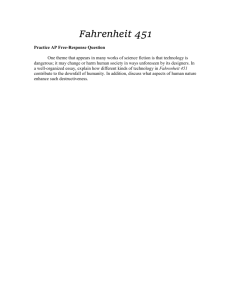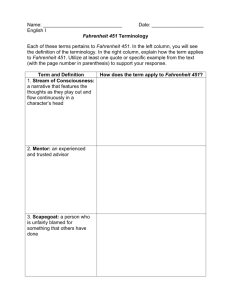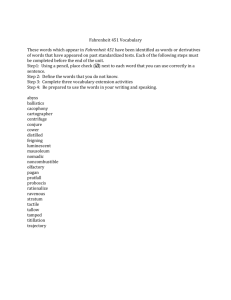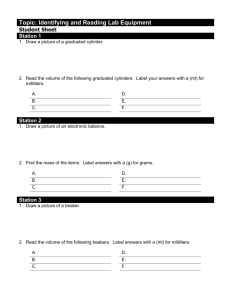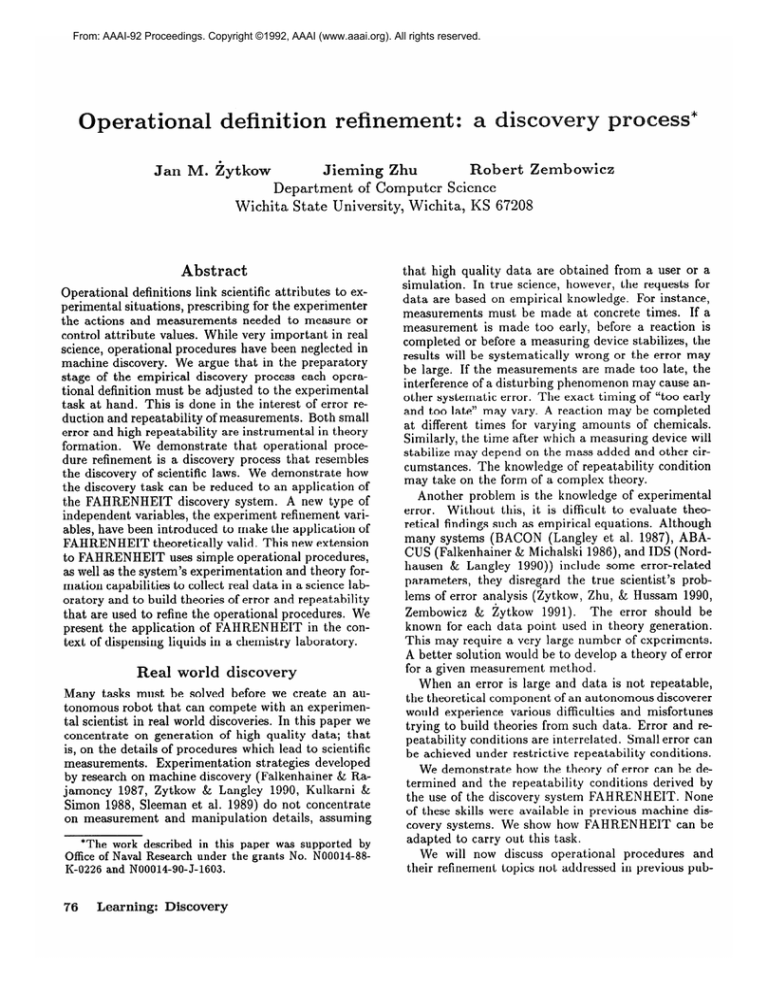
From: AAAI-92 Proceedings. Copyright ©1992, AAAI (www.aaai.org). All rights reserved.
Operational
definition
refinement:
a
obert Zembowicz
Jieming Zhu
Department of Computer Science
Wichita State University, Wichita, KS 67208
Jan M. iytkow
Abstract
Operational
definitions
link scientific attributes
to experimental
situations,
prescribing for the experimenter
the actions and measurements
needed to measure or
control attribute
values. While very important
in real
science, operational
procedures have been neglected in
machine discovery. We argue that in the preparatory
stage of the empirical
discovery process each operational definition must be adjusted to the experimental
task at hand. This is done in the interest of error reduction and repeatability
of measurements.
Both small
error and high repeatability
are instrumental
in theory
formation.
We demonstrate
that operational
procedure refinement
is a discovery process that resembles
the discovery of scientific laws. We demonstrate
how
the discovery task can be reduced to an application
of
the FAHRENHEIT
discovery system.
A new type of
independent
variables, the experiment
refinement variables, have been introduced
to make the application
of
FAHRENHEIT
theoretically
valid. This new extension
to FAHRENHEIT
uses simple operational
procedures,
as well as the system’s experimentation
and theory formation capabilities
to collect real data in a science laboratory and to build theories of error and repeatability
that are used to refine the operational
procedures.
We
present the application
of FAHRENHEIT
in the context of dispensing
liquids in a chemistry laboratory.
Real world discovery
Many tasks must be solved before we create an autonomous robot that can compete with an experimental scientist in real world discoveries. In this paper we
concentrate
on generation
of high quality data; that
is, on the details of procedures which lead to scientific
measurements.
Experimentation
strategies
developed
by research on machine discovery (Falkenhainer
& Rajamoney
1987, Zytkow & Langley 1990, Kulkarni &
Simon 1988, Sleeman et al. 1989) do not concentrate
on measurement
and manipulation
details, assuming
*The work described
in this paper was supported
by
Office of Naval Research under the grants No. NOOOl4-8%
K-0226 and N00014-90-J-1603.
76
Learning: Discovery
that high quality data are obtained
from a user or a
simulation.
In true science, however, the requests for
data are based on empirical knowledge.
For instance,
measurements
must be made at concrete times.
If a
measurement
is made too early, before a reaction is
completed or before a measuring
device stabilizes, the
results will be systematically
wrong or the error may
be large. If the measurements
are made too late, the
interference of a disturbing
phenomenon
may cause another systematic
error. The exact timing of “too early
and too late” may vary. A reaction may be completed
at different times for varying amounts
of chemicals.
Similarly, the time after which a measuring device will
stabilize may depend on the mass added and other circumstances.
The knowledge of repeatability
condition
may take on the form of a complex theory.
Another problem is the knowledge of experimental
error.
Without
this, it is difficult to evaluate theoretical findings such as empirical equations.
Although
many systems (BACON (Langley et al. 1987), ABACUS (Falkenhainer
& Michalski 1986), and IDS (Nordhausen & Langley 1990)) include some error-related
parameters,
they disregard
the true scientist’s
problems of error analysis (Zytkow, Zhu, & Hussam 1990,
Zembowicz
& Zytkow 1991).
The error should be
known for each data point used in theory generation.
This may require a very large number of experiments.
A better solution would be to develop a theory of error
for a given measurement
method.
When an error is large and data is not repeatable,
the theoretical component of an autonomous
discoverer
would experience
various difficulties and misfortunes
trying to build theories from such data. Error and repeatability
conditions are interrelated.
Small error can
be achieved under restrictive
repeatability
conditions.
We demonstrate
how the theory of error can be determined
and the repeatability
conditions
derived by
the use of the discovery system FAHRENHEIT.
None
of these skills were available in previous machine discovery systems.
We show how FAHRENHEIT
can be
adapted to carry out this task.
We will now discuss operational
procedures
and
their refinement topics not addressed in previous pub-
lications
in machine discovery.
Two earlier papers
(Zytkow, Zhu, & Hussam 1990, 1990a) reported the
applications
of FAHRENHEIT
to discovery of a theory helpful in developing analytical
instrumentation
in
chemistry, but the operational
procedures
were hardcoded into the experiment
control module, and all their
elements have been pre-programmed.
Interaction with the real world:
operational procedures
Each independent
and dependent
variable must be
linked to manipulations
(actions)
and measurements
available to the experimenter.
They are used to set the
values of independent
variables and to measure values
of dependent
variables obtained
in response.
Scientifically meaningful
manipulations
and measurements
can be reconstructed
in the form of operational
definitions (Bridgman
1927, Carnap 1936). Although each
scientific concept is typically defined by a coherent set
of operational
definitions
(Zytkow 1984), in this paper we will limit our attention
to a single definition
of one concept.
Each operational
definition
can be
viewed as a program, the elementary
instructions
for
which are primitive actions, instrument
readings, and
calculations.
For instance,
a procedure
that defines
mass difference caused by a particular
action can be
expressed as:
Mass-change(by
action
Mb =: measure
mass
Ma =: measure
mass
Ma - Mb
a) =
before
after
action
action
Mass
refinement:
if identical from the perspective
of independent
variables used in theory construction,
may yield different
results.
To analyze the differences, in all repeatability experiments,
two additional
independent
variables
can be used: time of measurement,
and the ordering
number of the experiment.
In our example this is the
number of the repeated transfer of the same amount of
water and the time at which the balance measures the
mass. We will concentrate
on the error and repeatability of mass measurements
for a single value of the
volume dispensed by the buret.
At each time, the beaker is represented
by the state,
including:
a
a
This procedure,
although
defining a theoretically
sound concept, requires adjustments
to a particular application:
the constraints
on the time before and the
time after, as well as the error of the procedure for a
particular
experimental
situation,
to which it is going
to be applied.
We claim that each operational
definition
must be
adjusted to the specific details of a given experiment,
in preparation
for the empirical discovery. The adjustment is based on a discovery process, that resembles
the discovery of scientific laws. It involves the analysis of error and the determination
of conditions
under
which experiments
are repeatable.
Measurement
Figure 1. The liquid transfer experiment setup. The buret
delivers lOm1 water to the beaker at a time.
a case study
transfer experiment
As an example,
let us consider an experiment
illustrated by Figure I, in which an electronic
buret dispenses water in the amount controlled
by FAHRENHEIT. Water is transferred
to a beaker, which has been
placed on a balance.
Volume dispensed by the buret
is the independent
variable, while mass at the balance
is dependent.
Our task is to determine
error and repeatability
conditions
for the Mass-change
procedure
provided in previous section.
The experiments,
even
substance:
mass:
values:
empty,
water,
the reading
of mass
and
the
like
The initial state of the beaker can be also controlled,
by draining the beaker or by filling it with a particular
amount of liquid.
Data
collection
and analysis
FAHRENHEIT
began the repeatability
and error experiment
by setting three independent
variables at a
constant value: substance
in the beaker to empty, dispensing volume to lOmL, number of dispensing to zero,
while varying time from 0 to 120, by sampling the balance at the rate of about 1.25 readings per second.
The first sequence of measurements
thus consisted of
weighing the empty beaker approximately
120 times.
As shown in Table 1, this sequence of balance readings has been recognized by FAHRENHEIT
as a constant, and the standard deviation has been found. The
error was not available for the first sequence of data.
This is a special application
of FAHRENHEIT’s
Equation Finder (Zembowicz
& Zytkow 1991). While the
error is assumed to be constant,
the value of error is
determined
as the standard
deviation
of the best fit
within a small set of simple equations.
If the set of
data is large, while the equations
are simple, there is
no risk to introduce
overfit, which would result in an
underestimated
error. The initial value of error can be
Zytkow, Zhu, and Zembowicz
77
time (second)
0
1
2
. . . . ..
98
balance reading
bv-4
223.827
223.827
223.827
. . . ..e 223.829
discovered regularity:
constant,
m = 223.827, error: 0.002
Table
1. Partial
list of the first
number of
mass
transfers
1
2
3
4
5
6
7
8
9
10
1 regu!arrty
regularity
r measuremenl
start
time
0
0
0
0
0
0
0
0
0
0
founcL for
found for
Table 2. For each dispensing
those readings
is found
120 balance readings
(made
100 seconds),
the discovered
of the slope for each linear
The second variable varied by FAHRENHEIT
is the
ordering number of dispensing.
1OmL of water is dispensed each time from the buret to the beaker, roughly
every 120 seconds.
This dispensing
process has been
repeated 10 times, while balance readings were sampled continuously
at the rate of about 1.25 readings
per second, leading to that approximate
10 x 120 readings have been collected (Table 2 and Figure 2).
Each sequence of data, one at a time, is analyzed by
the Equation
Finder.
Because the error is small, no
sequence of data, as depicted in Figure 2, fits a single
equation.
The data partitioning
mechanism
is therefore invoked, finding a unique special point in each
sequence (see Table 2). The initial steep raising line
corresponds to the mass change during the dispensing.
Each dispensing
lasted about 10 seconds. The second
sequence of data corresponds
to a far more stable situation following each dispensing.
No equation within
error is detected for the first partition,
while a linear
equation is found for each second partition of data (Table 2), with a small error in the slope. Negative slopes
Learning: Discovery
223.829
regularity
and error.
fi period (in seconds)
partition
point
10
9
9
9
9
process, the start point of stable readings is detected
(the error
223.829
100
discovered regularity for stable readings
m: mass in grams, t: time in seconds
in parentheses,
the error of the slope
m= -0.000213t
+ 233.685
(5.6 x lo-“)
m= -0.000203t
-I- 243.517
(5.5 x 10-6)
m= -0.000242t
+ 253.454
(5.5 x 10-6)
m = -0.000229t
+ 263.398
(5.6 x 10B6)
m= -0.000240t
+ 273.339
(5.6 x 10-6)
10
m = -0.000210t
+ 283.286
(5.5 x 10e6)
m= -0.000229t
9
+ 293.235
(5.6 x 10-6)
m= -0.000212t
+ 303.182
(5.6 x 10-6)
9
m= -0.000202t
10
+ 313.131
(5.5 x 10-6)
125
11
m= -0.0002365
+ 323.082
(5.6 x 10-6)
partition
points: t = 9.5, v th error = 0.6
slopes: t = -0.000222,
with error = 9.6 x low6
end
time
124
124
126
123
124
126
123
123
126
changed at a later time, if in similar but better controlled circumstances,
a smaller value of error is detected. In our experiments,
the value of error has been
determined
as 0.002, which is almost the minimum discernible value for our balance and never changed. This
value has been used repeatedly
as the error, when analyzing the future readings.
Repeatability
conditions
are always satisfied by a constant,
so FAHRENHEIT
finds this experiment
completely
repeatable,
without
limiting conditions.
78
in
99
regularity
(partition
point) and the regularity
for
in parentheses).
indicate the decreasing mass of the beaker, which, as
we know, is due to liquid evaporation.
Because repeatability
is satisfied only by a constant, now the data
are searched incrementally
from the partition point, using the initially determined
error, to detect the scope
of constancy.
Because the slope is very small, given
the error of mass as O.O02g, for about 20-30 seconds
following each liquid transfer, the mass readings fit a
constant.
The lower bound of the constant is the partition point, while the upper bound is approximately
20-30 seconds later.
A similar constancy
is found for the data immediately preceding the dispensing.
Now the operational
definition can use these constraints,
so that the difference between the mass at the point of the first stabilized reading after dispensing
and the mass of the last
stabilized
reading before dispensing
is computed
(Table 3). When FAHRENHEIT
generalized
the location
of each partition point, the constant has been detected
at 9.5 seconds with an error of 0.6 second.
Both the experiments
and the theoretical
have been fully automated.
Theory
of repeatability
derivations
and error
Now that we have described details of our experiment,
let us summarize the theory of repeatability
and error,
and the mechanism
by which the initial operational
definition controls the experiments.
#
1
2
vol. dispensed
9.857
9.854
discovered regularity:
constant,
3
dispensing
Table 3. List of ten actual
dispensed
volumes,
4
5
6
9.969
9.964
9.973
9.961
m = 9.947, error = 0.03
their regularity
and standard
7
9.975
8
9.973
9
9.973
10
9.971
deviation.
323.046
L--**m** ~o~b);ll
.
.
.
.
.
.
.
.
.
.
.
.
.
e
(4
f(s)
l...**...
Q d
Figure 2. (a): mass of the empty beaker is constant,
error is very small; (b) and (c): as water is added, mass increases.
readings stabilize after about 10 seconds; error becomes small. However, a slow long term phenomenon
of evaporation
can be noticed by comparing
the difference in mass: 323.0809
at 1240s; 323.0469
at 14009.
Refinements of an operational definition
Each operational
definition
requires specific actions
and measurements.
The task is to detect limitations
on the time and circumstances
in which these actions
and measurements
are performed.
Another task is to
determine the error of the procedure.
In our example,
several constraints
on time have been found, and different theories have been found for an empty beaker and
a beaker which contains water. Other circumstances,
such as the initial mass of the beaker before each dispensing, could be examined
also, perhaps leading to
more complex theories.
In our example, two specific
measurements
required by the definition
are: (1) the
mass before dispensing,
and (2) the mass after dispensing.
The repeatability
and error for both guide
the refinement process.
The experiment refinement variables
In law discovery, following BACON, FAHRENHEIT
distinguished
between
independent
and dependent
variables, trying to find a theory that would include all
independent
variables.
In real world applications,
the
potential
independent
variables
are those associated
with manipulation
procedures,
while potential
dependent variables are those associated with measurement
procedures.
In repeatability
and error analysis, all independent
variables can be used to explore the space of circumstances that decrease error and improve repeatability.
Variables, which are not involved in the future theory
formation task, can still be very important
in controlling error and repeatability.
For each discovery task,
therefore, all variables are divided into two categories
(Figure 3). The first category includes variables for
which FAHRENHEIT
is supposed
to build a theory
and are called theory formation
variables.
In our ex-
The
(d)
(b). Experiment refinement variables; they
are used to determine
the repeatability condi-
(a). Theory formation variables; traditional application of
BACON
and
FAHRENHEIT
tions and error.
Figure 3. Two types of independent
variables. The space of
independent
variables decomposes
into two subtypes:
(a).
for theory formation;
(b). for experiment
refinement.
Theory of error, which uses experiment
refinement
variables,
must be found before FAHRENHEIT
can work on the main
theory for the theory formation
variables.
periment,
this first category includes the volumes dispensed by the buret.
The second category includes
control variables that are of no direct interest to the
current theory formation
task. We call them experiment refinement
variables.
Some of these variables
may be irrelevant to the measurements,
but some of
them may influence their results.
If that happens for
a variable V, FAHRENHEIT
finds a constraint
on V
that limits its influence on the experiment.
In our exincludes
two variables
periment,
the second category
which are always available to the experimenter:
the
number of times the liquid is added, and the time at
which
the
reading
can be controlled,
still be varied.
The use
is conducted.
If no other
the last two types
variables
of variables
can
of special points
FAHRENHEIT
includes
mechanisms
cial points” such as maxima,
slope, and so forth (iytkow,
to
detect
“spe-
minima, big changes in
Zhu & Hussam 1990).
Zytkow, Zhu, and Zembowicz
79
Special points can be used for data partitioning.
When
a regularity cannot be detected for all data, FAHRENHEIT finds special points and partitions data accordingly. Then FAHRENHEIT
can find regularities
on
boundaries of regularities,
and regularities on all types
of special points. Both features have been used during
repeatability
analysis in our example.
Special points
have been used as a tool for data partitioning,
so that
the regularity search may succeed in partitions.
For
instance, a regularity on a boundary of the constant
regularity is used to define a repeatability
condition.
The
use of error
For each new variable V generated by FAHRENHEIT,
such as the slope of a particular
regularity, or in the
boundary of a regularity, the system finds the error of
each value of V. Detected errors provide important information about data, and are used to find regularities
and special points. For instance, the error reported in
Table 1 is used to determine all regularities for water
evaporation.
When a sufficient set of values of two variables (independent and dependent) has been collected, FAHRENHEIT calls Equation
Finder and then considers the
best equation discovered by EF. If the error of the
dependent variable is known, EF uses it to evaluate
equations and estimate errors of equation parameters.
If the error is not known, which is the case at the beginning of the process, EF assumes a model of constant error and estimates for each in a small class of
simple equations, the measurement
error from the fit.
The equation with the smallest error is considered to
be the best. In this way FAHRENHEIT
obtains not
only the best equation, but also the estimation of data
error.
The lucky coincidence
in our experiment
has
been that the first sequence of measurements
was performed on the empty beaker. Since the regularity is a
constant for all data, this error is minimal. If the initial
sequence of measurements
were not so fortuitous,
the
initial error could be larger. But whenever the system
finds a sequence of data that is constant within smaller
error, it uses that smaller error in future. This seems
intuitively plausible: when we discover that in special
circumstances
the weighing error is smaller, we change
our mind on the error of the device.
iscovery of repeatability and error
In the repeatability
study, FAHRENHEIT
varies one
variable in the category of experiment refinement variables at a time, while keeping all theory formation
variables constant.
In the liquid transfer experiments,
FAHRENHEIT’s
space of experiment
refinement variables includes time, the number of the dispensing, and
the empty/non-empty
condition
of the beaker.
The
initial experiment
is conducted with an empty beaker
and zero repetition of dispensing.
With the water being added to the beaker, focus is shifted to the “water
in beaker” subspace, where the remainder of the bal80
Learning: Discovery
ance readings take place. After each successive 1OmL
of water is added, the readings are collected over a
period of time.
After each sequence
of data has been collected,
FAHRENHEIT
tries to find regularities
in the data.
If the regularity is not constant,
the FAHRENHEIT
reconsiders the same data, looking exclusively for the
range of constancy.
The system expects that some data
fit a constant within acceptable error and that the rest
may either follow another regularity or increase the error. FAHRENHEIT’s
capability
for finding multiple
regularities and their boundaries
is used on this task.
In our approach, only a part of data is repeatable (constant) because the error is very small. FAMRENHEIT
searches for a constant which is acceptable within error, and if it cannot find a satisfactory
constant for the
whole data set, it partitions the data and tries to find
a satisfactory
constant in each data subset separately.
In order to determine whether the fit is satisfactory,
FAHRENHEIT
uses the minimum value of experimental error or error which has been detected in the first
sequence of data.
The dimension of the dry beaker is important
because two classes of regularities
were discovered:
the
constant
mass for the dry beaker and, the negative
linear slope when water is present in the beaker.
FAHRENHEIT
cannot generalize these two types of
regularities,
so they are kept separately, and the property of the beaker, empty vs. containing water, is used
in the refined procedure.
It is always desirable to increase the range of repeatability
and to decrease error,
but there is no satisfactory
universal method that will
determine the tradeoff between error and repeatability and decide on the optimal combination
of both.
The simplest algorithm
would compute the average
and standard deviation for each sequence of data. This
way we can maximize the range of repeatability
but we
also maximize the error. Usually the error computed
this way is unacceptable.
The selection of a viable
tradeoff depends on real world considerations
external
to FAHRENHEIT.
Scientists may prefer the smallest
error within acceptable costs, while in applications
we
may prefer the largest repeatability
range within acceptable error. FAHRENHEIT
uses the minimum error of mass for all datasets it has analyzed.
In our
experiment,
the smallest error occurred in the first sequence of data.
Then the system finds the range of
repeatability
within that error.
Operational
definition
refinement
In our example, an operational
procedure to measure
the mass dispensed by the buret has been originally
defined as:
Mass-change(by
= mass(after
action
action
Following the repeatability
inition can be refined to:
a)
a)-mass(before
action
and error analysis,
a)
that def-
Mass-change(by adding x mE of water):
Mb =: if beaker empty, get mass at any
time before
dispensing;
if water
in beaker, get mass at
t seconds (t < y) before
the beginning
of dispensing,
#a =: mass at t seconds
(y+z > t > z>
of dispensing
after
the beginning
Ma - Mb
For
x=lOmL the
error
of mass-change
is
0.03
where z is the value of the independent
variable for
the buret (so far only the dispensing
of 10mL has
been examined,
but, in the BACON style, the system is ready for a generalization);
?/ is the boundary
on repeatability
for the beaker which contains water:
y 5 20 - 5(error) = 15sec; z is obtained from the measurement of dispensing
time. It has been determined
that t > z(z = 9.5 + O.G(error) = lOsec), the constraint generated by dispensing,
while the evaporation
t < y + z. If the exprovides the second constraint
periments
continued for different values of z, it would
turn out that there is a regularity
(proportionality)
between z and x. The new operational
definition contains two dependent
variables, y and z. They can be
treated in the same way as parameters
included in the
regularities,
maxima, and the like. For instance, they
can be generalized.
For another value of the dispensed
volume, y will remain constant,
while z will change.
Eventually,
it can be discovered that z = a x 2, where
x is the dispensed volume.
If there is leeway left by the repeatability
conditions,
then the experiment
controller, which assigns tasks to
device controllers can make its choice of measurement
time for the mass reading,
within constraints.
This
helps in experiment
planning.
Conclusions
As we have shown by studying
a very simple chemistry experiment,
FAHRENHEIT
can be used to refine
an operational
procedure by discovering
repeatability
conditions
and experimental
error. The refined procedure can be applied within the context of a given
experiment.
For other experiments,
refinements
may
produce different results. Although the discussion was
limited to one particular experiment,
the same method
can be applied to other laboratory
situations.
For example, if an acid is dispensed and the pH value is measured, how long should the pH-meter wait to read the
pH value, before reagents are fully mixed by the stirrer,
and then, how many readings are repeatable before liquid evaporates
or another process becomes significant
and influences the readings ? Waiting until the reagents
are fully mixed in pH reading is analogous to waiting
until the balance stabilizes in a weight reading.
The presented
paradigm
for operational
definition
refinement,
is a step towards application
of machine
discovery systems like FAHRENHEIT
to real-world
discovery problems.
Eventually
a truly scientific quality.
may reach
the results
Bridgman,
P.W., 1927. The Logic of Modern
New York, NY: Macmillan.
Physics.
Carnap,
Philoso-
R. (1936).
phy of Science,
Testability
and Meaning,
3.
Falkenhainer,
B.C., & Michalski,
R.S., 1986. Integrating Quantitative
and Qualitative
Discovery:
The
ABACUS System, Machine Learning, 1: 367-401.
Falkenhainer,
dependencies
perimentation,
Conference
B.C., & Rajamoney,
S., 1987. The Interof Theory Formation,
Revision, and ExProceedings of the Fifth International
on Machine Learning, 353-366. Los Altos,
CA: Morgan
Kaufmann
Publ..
Kulkarni,
Scientific
D., & Simon, H.A., 1988. The Processes
Discovery: The Strategy of Experimentation,
Cognitive Science, 12: 139-175.
Langley,
P.W., Simon,
H.A., Bradshaw,
of
G., 8r; Zytkow
J.M., 1987. Scientific Discovery;
An Account
Creative Processes. Boston, MA: MIT Press,
of the
Langley, P.W., & Zytkow, J.M., 1989. Data-Driven
Approaches
to Empirical
Discovery.
Artificial Intelligence, 40: 283-312.
Nordhausen,
B., & Langley, P., 1990. An Integrated
Approach to Empirical Discovery. in: J.Shrager & P.
Langley (eds.) Computational Models of Scientific Discovery and Theory Formation, 97-128, San Mateo, CA:
Morgan Kaufmann
Publ..
Sleeman,
D.H., Stacey, M.K., Edwards,
P., & Gray,
N.A.B., 1989. An Architecture
for Theory-Driven
Scientific Discovery, Proceedings of E WSL-89.
Zembowicz, R., Zytkow, J.M., 1991. Automated
Discovery of Empirical Equations from Data, Proceedings
of the ISMIS-91 Symposium, 429-440, Springer-Verlag.
iytkow,
J.M. 1984.
Compared
to Meaning
Partial
Definitions
Families in Natural
in Science
Language.
Sign, System and Function:
papers of the first and
second Polish-American
semiotics colloquia, 479-492,
Mouton
Publ..
Zytkow, J.M., 1987.
Combining
many searches
the FAHRENHEIT
discovery system.
Proceedings
Fourth International
281-287,
Los Altos,
Workshop
CA: Morgan
on Machine
Kaufmann
in
of
Learning,
Publ..
Zytkow, J.M., Zhu, J. & Hussam, A., 1990. Automated
Proceedings of
Discovery in a Chemistry
Laboratory,
the AAAI-90,
889-894, Menlo Park, CA: AAAI Press.
Zytkow, J.M., Zhu, J. & Hussam, A., 1990a. Determining Repeatability
and Error in Experimental
Results
by a Discovery System.
In: Ras Z., Zemankova
M.,
and Emrich M.l., (eds.), Methodologies for Intelligent
Systems 5, 483-445, New York, NY: Elsevier Science
Publ..
Zytkow, Zhu, and Zembowiez
81

